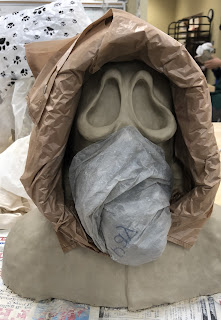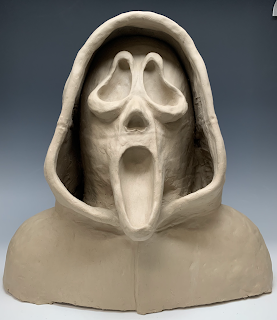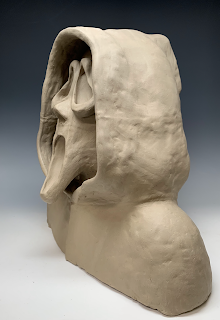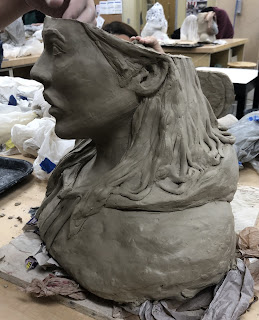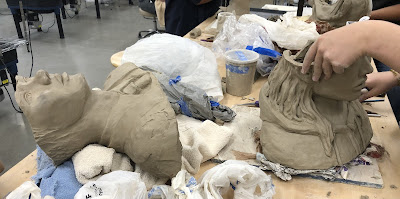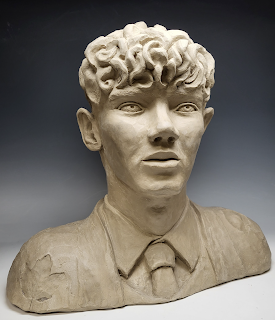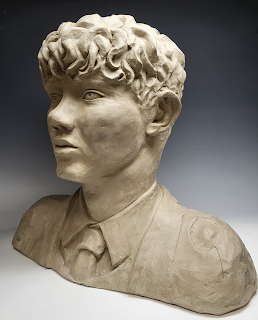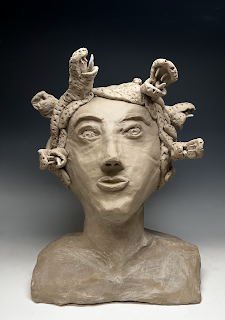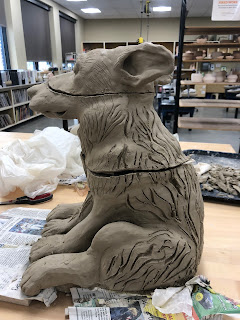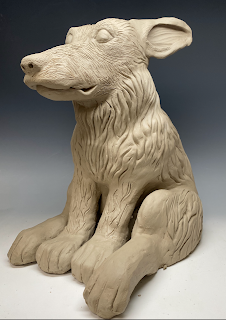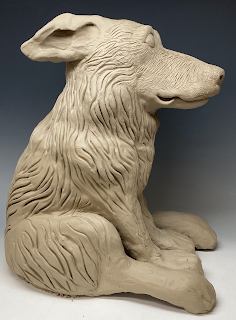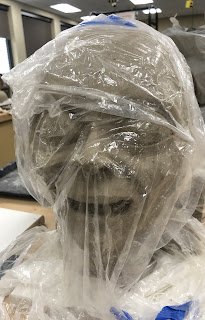Last week, students in my Winter quarter class started building their solid portraits. I've been pretty busy so far this winter, so I had not gotten around to posting the finished sculptures created by my fall quarter class.
 |
| painted solid portrait by Thai See |
The
solid built
portrait project is probably my favorite hand-building project. I enjoy the format of the class, and the way the students separate into different tools and techniques, then come together for this
solid building project. So this project is fun because we are
all working together.
 |
| Kate Winslet as Clementine (from Eternal Sunshine of the Spotless Mind) by Thai See |
|
I also enjoy it because of the way the students work on this project. Most students use an armature, but they aren't required to do so. However, because the build is solid and fairly large, the first day consists mostly of hitting clay with paddles to make it stick to itself or the armature. It's hard not to enjoy such a physical project.
 |
| Charlie from Heartstopper by Amy Matson |
|
I suppose it is also fun for me, because while the students are working hard, pounding on their pieces, making lots of noise and moving lots of clay around, I'm simply walking around, checking in with them, making suggestions, talking about their plans and proportions and the positiong of their armature.
 |
Nien Nunb from Star Wars by Carlos Garcia Alcantar
|
On the second day of the project, they are cutting, hitting, and still making large changes to their project. Eventually they start to separate and work at different rates, but by the start of the second week or so, by design, they are all ready to cut. And again, that day, I'm walking through, thoroughly enjoying myself, while they are all cutting and hollowing and again making big changes to their projects.
 |
| Scream, by Amanda Goodrich, glazed |
|
I never built this way, myself, in undergrad or in graduate school. I never really used an internal armature in my own work before I started teaching either. I've done so since, but I'm not even sure I had made and finished a full-side sculpture like this until my students had already done so in my class.
 |
| Scream, by Amanda Goodrich, side |
|
This process is just a bunch of fun for me and the students seem to really enjoy it too, though I know it can also be frustrating--and some of them feel the frustration more than others, of course. Some of the students who feel frustrated with the project are those whose work looks great to me and their classmates, but who have really high expectations of themselves. These students may be bothered that their first portrait project isn't as perfect as they imagine it could be.
 |
| Medusa by Valeria Alvarez |
Occaionally, I get a student who is so frustrated by the process that they end up disliking the end product. This happens in the throwing class sometimes, too. They expected the class to be easy or pure fun or something, but in the end they found it difficult and that somehow ruined the results for them. I find that both students who struggled and students who didn't appear to struggle can feel this way at the end of the quarter.
 |
| Two Geckos by Brooke Mason |
Of course there are some students who struggle or dislike the project or their final results because they didn't really put in the time. I didn't really have that happen during most of the quarter this year, but it has happened in the past.
 |
| Two geckos before firing by Brooke Mason |
The clay can be unforgiving, breaking or squishing if handled incorrectly or worked on too wet or too dry. Just missing some studio time can result in clay that's too dry and needs to be entirely restarted. This isn't such a big deal on the wheel, most of the time, but it can be a major problem with a hand-building project that took weeks to build.
 |
| Dog by Yarelli Sanchez |
The work I'm showing in this blog is (mostly) finished work as presented for the final critique. Students in the hand-building class
had 5 builds during the quarter and they were required to glaze at least 4 of them. One of the 5 could be painted, the other 4 could be fired in the cone 10 kiln in a reduction or oxidation atmosphere, in the raku or pit firing, or in a low fire kiln.
 |
| Dog by Yarelli Sanchez |
Finishing the work mostly meant glazing or painting, and many students used underglazes with glazes. Horsehair raku firing was also an option, though none of the solid portraits ended up being finished with only horsehair raku (one was done with horsehair then re-fired).
 |
| Dog by Yarelli Sanchez |
I also tell students that they can bring in non-ceramic materials after glazing and firing. This includes paint of course, but could also include epoxy, clear acrylic medium, hair, paper, or any other materials the student wishes to use. In the past students have added a dog collar, rubber, beads, staples and pieces of metal.
 |
Dog by Yarelli Sanchez
|
This quarter, just two or three students used something besides paint. One added some acrylic medium to increase the shine on her piece after firing. Another added hair to her Gollum. Though Gollum doesn’t have a lot of hair, it makes a real difference. His particular hairstyle reminds me of when my hair was falling out near the beginning of chemo.
 |
| Gollum by Amy Matson |
Amy, who created Gollum, actually used her own hair. She shocked her classmate when she cut it off during class, yakima more than she probably needed. Whenever I’ve made sculptures that incorporate hair, I’ve used the fake kind that you can buy in a cheap hairclip—but maybe that’s because I knew I’d eventually lose it all. (Hmm, now I’m wondering why I didn’t save my hair that fell out for use in my future sculpture.
 |
| Bantha by Julia Snow |
Hair and fur texture make a bit difference in making a sculpture look realistic, stylized, creepy, beautiful, or strange. In the fall, we had some pretty different approaches to hair and fur. Julia's Bantha has these tufts of fur, Yarelli's dog fur varies quite a bit across different parts of the body. Some others focused more on the form than the surface.
 |
| Bantha by Julia Snow |
I can't wait to share images from this quarter, with student's permission, because we have some very different approaches to surface texture happening. I feel like each class cohort can have a very distinctive feel, energy, or approach. This quarter 6 students from fall are continuing into the Winter quarter, meaning this cohort combines new and continuing students. I've been kind of surprised how different the energy is. The winter group is a good group, they're making work and rising to the challenge of the class, but the humor and perspective is just a little different. It's a little bit difficult to name.
 |
| Dog on Pillow by Thunder Morales |
I suspect part of the reason it feels so different is simply because half the class is working on different projects than the other. I've got six or seven beginners, doing the same assignments as the fall students, but with sometimes very different personal approaches. Then I've got 4 intermediates working on pretty independent and thus quite varied intermediate projects, and I've got 2 intermediate students who took the beginning class online or while I was on medical leave, which means their experience, background and perspective is pretty different.
 |
| Dog on Pillow by Thunder Morales |
I'm definitely not complaining. I've been really happy with how the group has worked together even with the different projects. They've now completed two and a half builds, and I'm pretty much always happy when the builds get done. Some of them had to push a bit to meet the last deadline, but that energy (oh no! here comes the deadline!) can yeild some very interesting and surprising results.
 |
| Dwight from The Office by Jordan Golob |
This week my three clay classes all start glazing. I'm looking foward to seeing what we get for the first firing, but I'm also interested to see how my intermediates approach glazing, having already had one or two quarters of experience prior to this class.

































